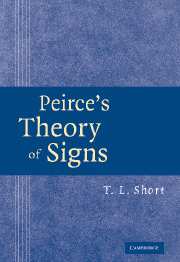Book contents
- Frontmatter
- Contents
- Preface
- Acknowledgments
- 1 Antecedents and Alternatives
- 2 The Development of Peirce's Semeiotic
- 3 Phaneroscopy
- 4 A Preface to Final Causation
- 5 Final Causation
- 6 Significance
- 7 Objects and Interpretants
- 8 A Taxonomy of Signs
- 9 More Taxa
- 10 How Symbols Grow
- 11 Semeiosis and the Mental
- 12 The Structure of Objectivity
- Bibliography
- Name Index
- Subject Index
1 - Antecedents and Alternatives
Published online by Cambridge University Press: 28 July 2009
- Frontmatter
- Contents
- Preface
- Acknowledgments
- 1 Antecedents and Alternatives
- 2 The Development of Peirce's Semeiotic
- 3 Phaneroscopy
- 4 A Preface to Final Causation
- 5 Final Causation
- 6 Significance
- 7 Objects and Interpretants
- 8 A Taxonomy of Signs
- 9 More Taxa
- 10 How Symbols Grow
- 11 Semeiosis and the Mental
- 12 The Structure of Objectivity
- Bibliography
- Name Index
- Subject Index
Summary
The purpose of this chapter is to put Peirce's semeiotic into context. What are its antecedents and alternatives? What is the type of question it is meant to answer? It might seem that we should begin with the theory itself, so that we can know what it is that we are talking about. But that theory is complex, and a preliminary statement of it would only raise objections before they can be answered. Sketching in the background leaves an empty space for the foreground objects. My hope is that this will allow you to see the shape of things to come and that it will provide some motive for enduring those rigors that lie grimly in wait.
Peirce
Charles Sanders Peirce (1839–1914), whose surname is pronounced ‘purse’, was a son of Benjamin Peirce, a Harvard professor of mathematics and astronomy and, at the time, America's foremost mathematician. Benjamin Peirce was also a major figure in, or, more accurately, one of the creators of, the American scientific establishment. With others, he founded the National Academy of Sciences and had a hand in much else of that kind. He recognized Charles' genius and raised him accordingly, with the consequence that the latter developed an extraordinary degree of intellectual discipline and almost no moral discipline. Although trained in chemistry, Charles Peirce made a number of profoundly original contributions of the first importance to mathematical logic, meanwhile earning his living making exacting empirical measurements in astronomy and geodesy (he made several important contributions to the theory and practice of measurement, as well).
- Type
- Chapter
- Information
- Peirce's Theory of Signs , pp. 1 - 26Publisher: Cambridge University PressPrint publication year: 2007



